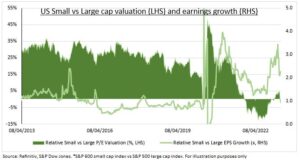PAIN: Small cap stocks are uniquely exposed to the faster economic growth slowdown that we see coming. As well as the less small and mid-size bank lending as deposit outflows tighten conditions. Small caps are more cyclical, less diversified, and have more debt. Both main small cap benchmarks, the Russell 2000 (where c.40% stocks are loss making) and S&P 600 (which only includes profit making stocks), are lagging but positive this year. Both indices have similar valuations than large cap, and twice the profits growth. This is superficially attractive (see chart) but we see worse to come. A return to cyclical stocks, like small cap, needs a capitulation in growth expectations. This lies ahead. This has more impact for the economy than stock market.
DRIVERS: Small cap stocks are very different from large caps. They are more sensitive to economic growth. They are smaller, with less diversification, and more focus on cyclical sectors like materials and financials, and less to tech. They are more domestic focused, carry more debt, and pay less dividends. 70% are clients of the small and mid-sized banks likely to see the biggest impact of the sector ‘scare’. More positively, there are many more small caps than large cap stocks, with less analyst coverage. This makes them more attractive for many stock pickers.
STRESS: The NFIB survey of US small companies shows a 15th month of weaker-than-average management confidence, tighter credit conditions, and the lowest proportion looking to expand since 2008 global financial crisis. This has big implications for the economy. Firms employing <500 workers make up 99.7% of US companies, and account for 46% of all jobs. They dominate the ag, construction, real estate, professional services, entertainment, and hotel and food service industries. By comparison small caps have a 15% weight in major stock market indices.

All data, figures & charts are valid as of 13/04/2023



